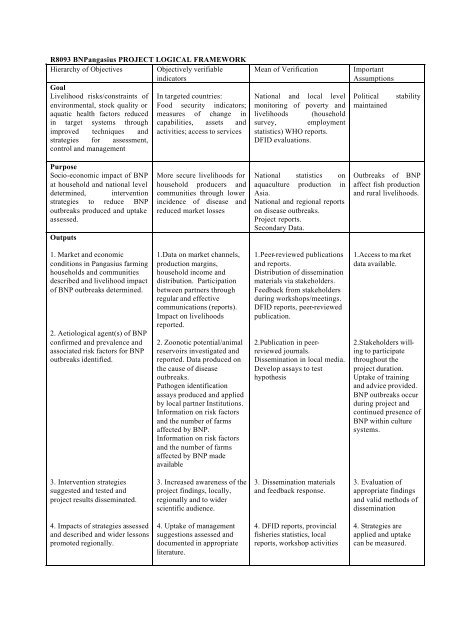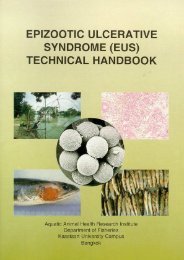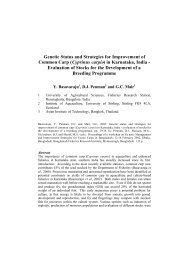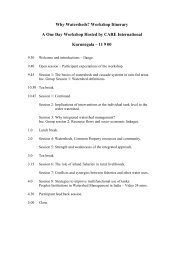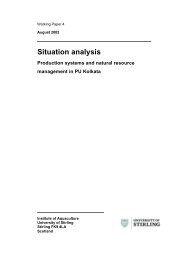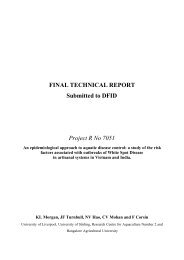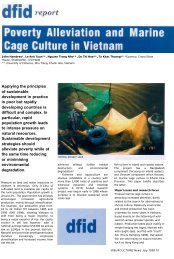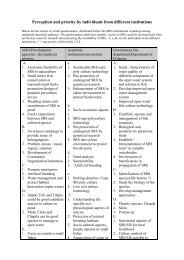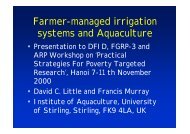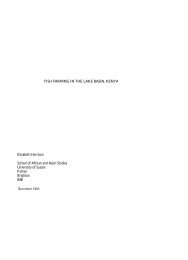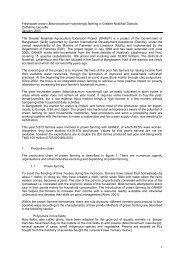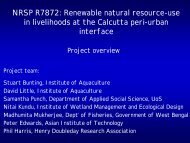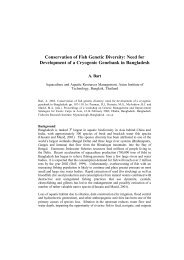Project Logframe (.pdf) - DFID@Stir
Project Logframe (.pdf) - DFID@Stir
Project Logframe (.pdf) - DFID@Stir
Create successful ePaper yourself
Turn your PDF publications into a flip-book with our unique Google optimized e-Paper software.
R8093 BNPangasius PROJECT LOGICAL FRAMEWORKHierarchy of Objectives Objectively verifiableindicatorsGoalLivelihood risks/constraints ofenvironmental, stock quality oraquatic health factors reducedin target systems throughimproved techniques andstrategies for assessment,control and managementIn targeted countries:Food security indicators;measures of change incapabilities, assets andactivities; access to servicesMean of VerificationNational and local levelmonitoring of poverty andlivelihoods (householdsurvey, employmentstatistics) WHO reports.DFID evaluations.ImportantAssumptionsPoliticalmaintainedstabilityPurposeSocio-economic impact of BNPat household and national leveldetermined, interventionstrategies to reduce BNPoutbreaks produced and uptakeassessed.OutputsMore secure livelihoods forhousehold producers andcommunities through lowerincidence of disease andreduced market lossesNational statistics onaquaculture production inAsia.National and regional reportson disease outbreaks.<strong>Project</strong> reports.Secondary Data.Outbreaks of BNPaffect fish productionand rural livelihoods.1. Market and economicconditions in Pangasius farminghouseholds and communitiesdescribed and livelihood impactof BNP outbreaks determined.2. Aetiological agent(s) of BNPconfirmed and prevalence andassociated risk factors for BNPoutbreaks identified.1.Data on market channels,production margins,household income anddistribution. Participationbetween partners throughregular and effectivecommunications (reports).Impact on livelihoodsreported.2. Zoonotic potential/animalreservoirs investigated andreported. Data produced onthe cause of diseaseoutbreaks.Pathogen identificationassays produced and appliedby local partner Institutions.Information on risk factorsand the number of farmsaffected by BNP.Information on risk factorsand the number of farmsaffected by BNP madeavailable1.Peer-reviewed publicationsand reports.Distribution of disseminationmaterials via stakeholders.Feedback from stakeholdersduring workshops/meetings.DFID reports, peer-reviewedpublication.2.Publication in peerreviewedjournals.Dissemination in local media.Develop assays to testhypothesis1.Access to ma rketdata available.2.Stakeholders willingto participatethroughout theproject duration.Uptake of trainingand advice provided.BNP outbreaks occurduring project andcontinued presence ofBNP within culturesystems.3. Intervention strategiessuggested and tested andproject results disseminated.3. Increased awareness of theproject findings, locally,regionally and to widerscientific audience.3. Dissemination materialsand feedback response.3. Evaluation ofappropriate findingsand valid methods ofdissemination4. Impacts of strategies assessedand described and wider lessonspromoted regionally.4. Uptake of managementsuggestions assessed anddocumented in appropriateliterature.4. DFID reports, provincialfisheries statistics, localreports, workshop activities4. Strategies areapplied and uptakecan be measured.
Activities1.1Workshops and meetings to encourage participation from identified stakeholders, and raiseawareness in national and regional context.1.2 Evaluate market/economic impact of BNP with market chain analysis using secondary dataon production costs/yields, and interviews with producers, export and domestic traders, andconsumers1.3 Define baseline data on livelihood options and coping strategies of pond and cage farmingfamilies with/out BNP experience using participatory methods.1.4 Assess impact of BNP out-breaks on livelihood options/activities using questionnaires andgroup meetings at household level2.1 Produce training and standard operating procedures (SOP) for bacteriology, parasitology andhistology analyses from farmed fingerling and grow out fish with and without clinical signs ofdisease.2.2 Produce assays for rapid confirmation of pathogen and test these using fish samples fromfarms with BNP outbreaks and laboratory-based experimental challenges.2.3 Perform longitudinal study with cage farmers in An Giang province within a singleproduction cycle to identify risk factors for BNP outcome.3.1 Develop intervention strategies through integration of results from activities 1.2, 1.4 and 2.3.3.2 Test intervention strategies at household and district level.3.3 Disseminate project results and intervention strategies both down and upstream using groupmeetings and workshops facilitated through existing regional networks.4.1 Assess uptake of strategies through interviews with farming households and extensionservices.4.2 Assess impacts of interventions and overall effectiveness of strategies through interviewswith key informants within farming community, extension services, commercial andGovernment sector4.3 Identify key lessons and issues for wider use4.4 Promote findings through regional networks and information systems – technical and policyissues


